RPM software is vital as it allows healthcare providers to track patients' health status outside traditional healthcare settings, leading to early detection of anomalies, improved care quality, and cost-efficiency. However, remote patient monitoring software development is challenging because of the software complexity and many factors that need to be accounted for.
Binariks is a successful remote patient monitoring development company capable of enhancing a healthcare provider's remote patient monitoring system by refining its architecture to be high-quality, HIPAA-compliant, and more capable of addressing healthcare community challenges.
Keep reading and learn about the tech trends, benefits, types of software, devices, apps, features, and how to build a remote patient monitoring app in our RPM guide.
Global remote patient monitoring system market
The global remote patient monitoring system experienced a surge due to the global Covid-19 pandemic. Even though Covid-19 no longer constitutes a public health emergency, the market shows no signs of slowing down due to the growing prevalence of chronic conditions worldwide and the aging population.
By 2024, about 30 million US patients will be using remote patient monitoring solutions, according to Business Insider (Source ). A 2021 MSI International survey also shows that 80% of the US population is positive about using remote patient monitoring, while 50% want to see RPM incorporated into medical care (Source ).
As of 2022, the value of the remote patient monitoring system market is estimated at $4.4 billion in 2022. It is expected to grow at 18.5% CAGP throughout the 2020s, as stated by GVR (Source ). About 80% of RPM devices are used by hospital-based patients. North America is the largest market for PRM devices at over 40%.
The key drivers of the remote patient monitoring market include the geriatric population, cost-effectiveness, and the growing holistic focus on lifestyle improvement. The market has a lot of additional potential with the promising technological advancements in IoT, machine learning, and AI. Moreover, legislation in the USA and EU countries makes implementing and reimbursing RPM services a lot easier.
Some examples of RPM software
Here are some of the popular RPM software to use or consider when developing your own.
- Doctolib: This is a France-based e-health platform very popular in Europe, known for video consultations and appointment booking. The special feature of the software is the management segment that allows healthcare providers to reduce the no-show rate and optimize the appointment schedule.
- Healee: A global telemedicine platform based in Bulgaria. It is famous for its AI-driven personal health assistant that offers users probable diagnoses and treatment recommendations.
- Medtronic: A global company focusing on medical devices along with RPM solutions. It is known for condition-specific RPM solutions for chronic conditions such as heart disease and diabetes and integration with the company's medical devices.
- Teladoc: A US-based international RPM company. It is known for its extensive network of licensed professionals across various medical fields. Its service is known for excellent remote monitoring and behavioral health services, including therapy and psychiatry.
In one of our previous posts, we talked more about these and other remote patient monitoring companies .
Remote patient monitoring system architecture
RPM systems are complex and may have many different elements, but the stables of the system architecture are the same across systems. Here are the main components of RPM architecture you need to consider to build an app for remote patient monitoring:
- Patient devices: Wearable or implantable devices capable of transmitting data wirelessly are essential to the RPM system architecture.
- Data storage: The sensors in the device transmit the data to the centralized storage, which also collects the data from analytical systems and e-medicine. Centralized storage is cloud-based.
- Software for data analysis: Data is processed in a centralized way. It involves notifications sent to patients and caregivers and complex predictive analytics that deal with potential health implications.
- Separate interfaces for patients and healthcare providers: Both patients and healthcare providers have interfaces to interact with collected and analyzed data. For healthcare providers, it is an electronic health record (EHR) system, a specialized RPM software interface, or an application. For patients, it's usually a mobile app or a web portal.
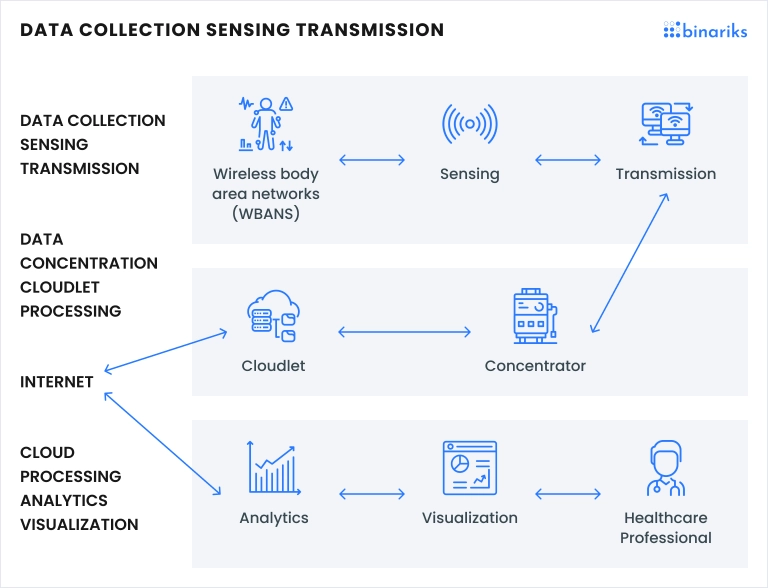
Benefits of remote patient monitoring system for patients
Remote patient tracking software is useful for patients with chronic diseases that require continuous care and monitoring. Some of the most important advantages of RPM systems for patients are as follows:
For patients
- Increased healthcare access
RPM systems allow patients to get care from the comfort of their homes, eliminating the need to commute to a medical center. This is especially advantageous for patients residing in remote regions or with restricted mobility.
- Early identification of health issues
RPM systems enable healthcare practitioners to monitor their patients' health in real-time, allowing them to spot any problems before they become more serious.
- Personalization of care
RPM systems help healthcare professionals to personalize care to individual patients' requirements based on health data and history. This can result in more effective therapies and improved results.
- Increased patient engagement
Since RPM systems allow people to manage their health data and interact more readily with their healthcare professionals, they can become more engaged in their treatment process.
- Decreased healthcare expenses
RPM systems can help lower healthcare costs by minimizing the need for hospitalizations and emergency room visits and allowing healthcare practitioners to react earlier to avert more severe health conditions.
The MSI International report says that 43% of users appreciate clinical remote monitoring systems for their convenience, 39% for efficiency, and 37% for control over personal health (Source ).
For healthcare businesses
- Cost efficiency: Pay $6,500 less per patient per year
“Overall, it’s estimated that widespread adoption of remote patient monitoring could save the US as much as $6 billion annually.”
Executive director of the Global Coalition on Aging
Building remote patient monitoring software reduces the number of human-operated processes, including in-hospital appointments. This helps to decrease the workload of the hospital staff. RPM can reduce hospitalizations by as much as 40% for some diseases and realize annual savings of $6,500 per patient (Source ).
By developing a remote healthcare app, healthcare companies can reduce labor and equipment upkeep budgets and lighten the strain on their staff. Remote tracking is often performed using patients' gadgets, which unloads the hospital equipment.
- Better patient outcomes: 5% reduction in patient readmissions
Plenty of documented cases prove that building a patient tracking system in hospitals increases EHR ROI (Source ). Virtual care was found to reduce medication errors by 24%, patient-reported pain by 10-14%, and potentially lower hospital readmissions with 5% fewer returning patients than standard care (Source ). Wireless patient monitoring devices provide doctors with regular patient health updates, enabling early detection and prompt response to potential health issues, thereby averting emergencies.
- Improved quality of service: 43% of patients approve
Nowadays, People want to manage their health through their devices because access to healthcare providers enhances their sense of security.
Doctors can develop personalized approaches and drive better healthcare results.
- Management optimization
Remote monitoring healthcare solutions help to optimize the schedules of practitioners. Doctors are no longer overloaded with appointments, which improves their efficiency.
- Better chronic disease prevention and management
Patients can monitor their glucose levels and hypertension symptoms without hospitalization with RPM solutions, decreasing the risk of chronic diseases.
RPM mobile app development allows hospitals to manage chronic conditions treatment, which amounts to billions annually.
Disease | Cost per year |
Prediabetes | $43.4 billion |
Chronic Obstructive Pulmonary Disease (COPD) | $49 billion |
Heart failure | $53 billion |
Chronic kidney disease | $81.8 billion |
Hypertension | $91.4 billion |
Diabetes | $327 billion |
Obesity | $147 billion |
- Promotional opportunities
RPM mobile app development has excellent market potential. It increases a patient’s awareness of a provider. Medical apps for patients can advertise specific services based on individual needs and increase a healthcare provider’s online visibility.
- Increased security in the age of pandemic
During the Covid-19 pandemic, the risk of contracting a disease while visiting a hospital increased, and the workload of healthcare professionals increased. Remote capabilities of RPM apps provide additional security in times of pandemic.
Want to become HIPAA-compliant?
Learn about best practices of FHIR implementation.

Types of remote patient monitoring software
RPM technology was widely accepted during the pandemic and is now applied to meet versatile requirements.
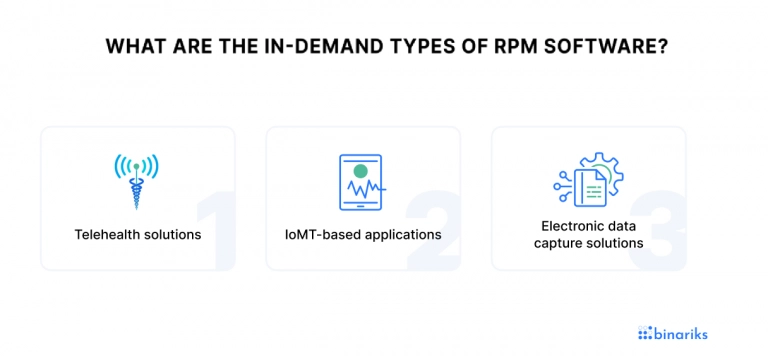
- Telehealth solutions allow patients to communicate with practitioners without going to the hospital. These include file exchange, teleconferencing, and instant messaging. It is used in therapy, rehabilitation, ophthalmology, and dermatology.
- IoMT-based applications use medical devices installed on patients' smartphones or embedded in medical devices. They monitor patient health metrics at home through IoT technology.
- Electronic data capture solutions are used to identify health conditions and subjective feelings, such as pain levels.
Types of remote patient monitoring devices
RPM devices are classified according to their purpose. Here are the most widely distributed types of remote patient monitoring devices:
Cardiac monitoring devices
The majority of people can check their heart rate exclusively in medical facilities. In the US, the annual cost of cardiac disease treatment is $53 billion. Spotting the early signs of heart-related health issues without constant control is complicated.
That’s why cardiac monitoring devices are a great addition to check-outs. They provide patients and doctors with up-to-date information about the state of the patient’s heart. Practitioners can track how specific activities impact heart rate and adjust the treatment plan accordingly.
Blood glucose monitoring device
Diabetes is one of the most frequently diagnosed health conditions which requires constant observation. This RPM device helps people track their glucose fluctuations and share the information with their doctors.
Depression and mood monitoring devices
Depression and mood monitoring devices monitor physiological parameters associated with mood swings. The software gathers data on heart rate, eye movement, and blood pressure. All that data goes directly to practitioners and doctors who use it to detect potential depression symptoms.
Technologies for COPD and asthma
People diagnosed with Chronic Obstructive Pulmonary Disease (COPD) need software that reminds them to use inhalers to avoid attacks and potential triggers. The reminders are based on the doctor’s recommendations to help patients keep up with the schedule. RPM solutions can also track data on attack frequency and even grasp the environmental changes that trigger them.
Pregnancy monitoring systems
The pregnancy monitoring systems collect data about the mother’s and child’s health. These systems help medical professionals anticipate and manage potential complications, improving the likelihood of a safe pregnancy and healthy birth.
Sensors for digestive systems
Digestive system sensors monitor gastrointestinal health, including pH levels, temperature, pressure, and bacterial composition, assisting in the diagnosis and management of disorders like Irritable Bowel Syndrome (IBS), Inflammatory Bowel Disease (IBD), Gastroesophageal Reflux Disease (GERD), and other digestive conditions.
Types of remote patient monitoring apps
If you want to build a patient remote monitoring system, you can take inspiration from a wide range of solutions that monitor health conditions remotely.
- IoT medical application. The wearables for heart attack prevention, glucose trackers, etc., gather vital information about health and generate alerts in emergency cases. That's why you should consider making an Internet of Things (IoT) solution compatible with a wide range of wearable medical devices.
- Questionnaire application. Some patients respond better to questionnaires and share their current health data willingly. They are especially successful in tracking mental illnesses and depression. In fact, questionnaires are one of the easiest medical solutions from the perspective of remote patient monitoring app development. They are quite undemanding: they require zero purchases from providers.
- Video conferencing applications. The remote patient monitoring software development of video conferencing apps has a bunch of invaluable functions. It can be used for examinations, appointments, and prescribing drugs without commuting. You can also extend the videoconferencing app's features by adding queue management, electronic medical records, billing, conferencing for doctors, etc.
- Precision medicine solution. This type of remote patient monitoring app is used for research. In essence, they anonymize participants' health data and represent it in an analytical report.
Binariks is an experienced tech partner with extensive experience in remote patient monitoring app development , healthcare interoperability solutions , healthcare cloud solutions , telemedicine software development , and custom healthcare software development in its broad meaning.
We will help implement cutting-edge solutions that will bring you above the competition.
Build compliant and secure RPM apps with healthcare software engineering experts
Trends and frameworks for RPM software development
There are two large trends taking place in the RPM industry at the same time. The first one is the transition to value-based, patient-centric care and outcomes. Both clinics and patients want to use their funds to address health issues in a more personalized way. The second trend is the aging population vulnerable to pandemics and chronic diseases.
These major trends give a way to precision medicine, predictive analytics , IoT , and machine learning. Here are some interesting statistics on the growth of each tech remote patient monitoring technologies trends for 2023 and beyond in healthcare:
Predictive analytics and big data
The global predictive analytics market is now worth $9.5 billion according to Acumen Research and Consulting. By 2030, the market is expected to reach $87.5 billion with a CAGR of 28.2%. One of the most straightforward ways to use predictive analytics is to make forecasts of healthcare demand.
Healthcare providers will use big data analysis to gather and analyze information on a much bigger population base. This will open up new ways for investigation and treatment options.
By gathering big data and running predictive analytics, healthcare providers are preparing to handle the following issues:
- Preventing readmissions
- Forecast appointment no-shows
- Speed up insurance claims submission
- Detect health issues at early stages
- Enhance cybersecurity
- Managepopulation health
- Increase patient engagement and outreach
- Predict suicide attempts
This trend doesn't exist in a vacuum. It needs data, a lot of health data gathered from millions of users and operated in a secure and ethical way. That's where we need to talk about our next tech trend in remote patient management – the Internet of Things.
Internet of things and sensor-rich wearables
By 2027, the global internet of things in the healthcare market is predicted to grow from $113.75 billion in 2019 to $332.67 billion. The CARG of 13.20%. You already know that IoT in healthcare heavily relies on wearables and various health data devices. The application of IoT healthcare wearables will only grow in the following years.
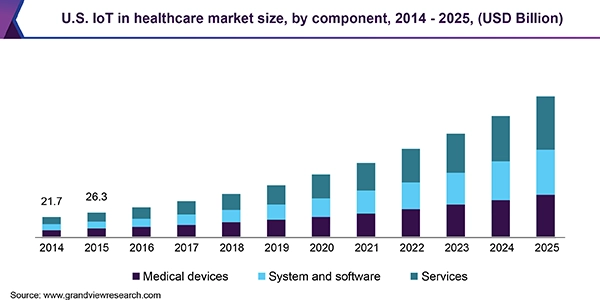
In 2023, we will see more clinics integrating IoT systems connected to sensor-rich gadgets that tirelessly read, track, and analyze the health data of each patient.
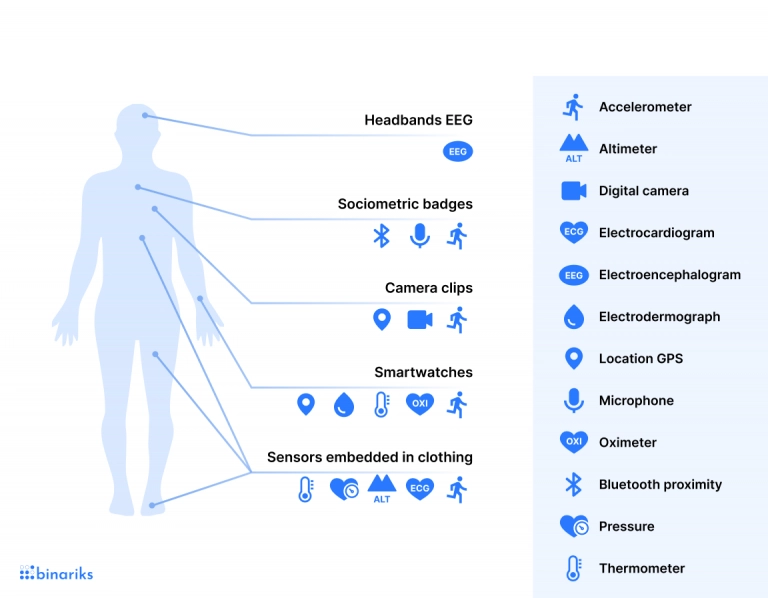
Many healthcare providers enhance their remote health monitoring system through IoT integrations and you can, too. Book a meeting with our tech specialists and we will help you bring your IoT healthcare solution to life.
We're getting closer to answering how to build a remote patient monitoring system. First, let's take a look at the key components your system should include and how they interact with one another.
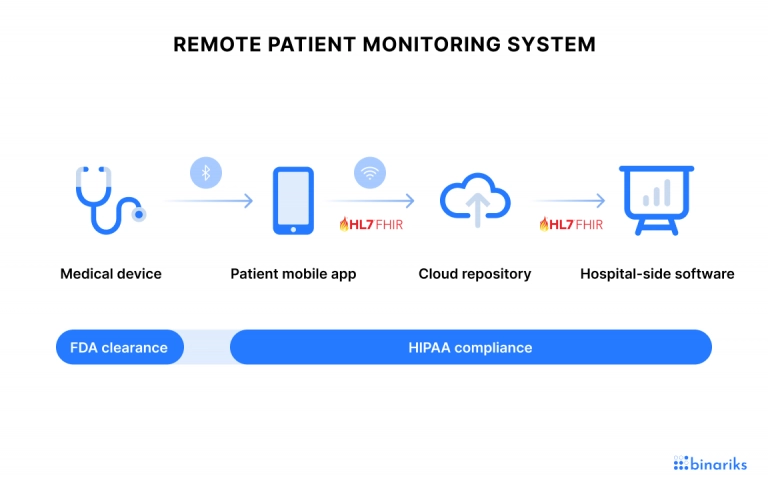
Remote patient monitoring system
This system connects the medical device that gathers health data and sends it to the healthcare provider. Mind that the FDA authorizes only wireless, non-invasive tools for remote patient management including electronic thermometers, electrocardiographs (ECGs), cardiac monitors, apnea monitors, spirometers, oximeters, audiometers, electroencephalographs (EEGs), cardiac monitors, breathing frequency monitors, etc.
Patient mobile app
The patient-facing mobile application's function is to gather the data from wearables and sensors and send it to the hospital staff. Because the patient-facing mobile app operates with health data, it should meet the strict criteria: comply with HIPAA regulations, support BLE for exchanging the data between devices, secure API integrations, etc.
What can a patient mobile app contain? You can enrich your app functionality by adding various data visualization , providing educational information, sending reminders, sharing medical questionnaires, and, what's most important, adding video, audio, or chat to let patients communicate with their doctors.
Cloud repository
Cloud database that receives and stores the raw health data collected from the patient-facing mobile apps. It's not mandatory to use a cloud repository since some systems allow direct-to-cloud connectivity for devices. Thus, a patient doesn't need to use a dedicated mobile app.
Hospital web application
Just like mobile apps, hospital apps work with electronic health information, hence, have to comply with HIPAA requirements. What's more, a hospital’s EMR system and RPM web platform have to be integrated via FHIR-based API to improve interoperability. As a rule, a hospital-facing app usually includes individual modules for decision support, reporting, notifications, and analytics.
Sensors or smart connected devices for patient monitoring
To gather patient vitals such as body temperature, blood pressure, and sweat and upload them to the cloud RPM server through communication protocols (Wi-Fi, NFC) for further analysis. This part of the solution communicates with the patient tracking software.
Features for your remote patient monitoring system
There are plenty of features you can implement in your RPM system. Some of them are quite basic while others serve more specific requests. Here is an inspiration list of the features that you can add to your solution.
Data analytics and reporting |
|
Patient-doctor online communication |
|
Patient data security |
|
Real-time patient health tracking |
|
IoT-based monitoring of RPM devices |
|
Accessibility features |
|
Integrations for RPM Systems
Luckily, the health tech market is flooded with off-the-shelf solutions that would otherwise take a long time and money to engineer. So if you are planning to build a remote patient monitoring application, consider these two popular types of integrations.
Smart connected patient monitoring devices
Connecting an RPM system with linked patient monitoring devices is critical for obtaining accurate and real-time data, which is required for optimal patient care.
Healthcare practitioners acquire quick and precise data on a patient's health state by connecting the RPM system with linked equipment such as blood pressure monitors, glucometers, or pulse oximeters.
This data may be automatically communicated to the RPM system, allowing healthcare practitioners to monitor patients and intervene remotely.
Connecting RPM systems with linked devices can also minimize the need for manual data entry and remove mistakes, enhancing patient care efficiency and accuracy.
Overall, combining RPM systems with linked patient monitoring devices has the potential to improve patient outcomes and increase the quality of treatment offered.
EHR/EMR system
What do you get when you connect an RPM system with an EMR system? First of all, you gain interoperability. Secondly, healthcare practitioners gat an opportunity to communicate and collaborate in real-timreal time
It enables the automated transmission of patient data from the RPM to the EMR system, removing the need for human data entry and lowering the chance of mistakes.
This interface gives healthcare practitioners access to real-time patient data, allowing them to make informed decisions and deliver more individualized treatment. Moreover, integration with an EMR system can enhance patient safety by allowing healthcare practitioners to examine a patient's entire medical history and prescription list, lowering the likelihood of harmful drug interactions.
Overall, combining RPM and EMR systems is critical for improving patient care and healthcare efficiency.
How to implement RPM software in your business processes?
Now let’s talk about some practical things that you should implement in your business model to incorporate RPM software into your system with ease.
1. Ensure robust data security
We can’t overstate the importance of data security in RPM solutions. First, it’s one of the major requirements of the HIPAA rule. As an authorized party that operates with electronic health data, you are responsible for the consequences of data breaches.
What do we mean when we say “robust data security”? In essence, it means that every element of the data exchange process must be physically and virtually secured. Electronic health information is more expensive than credit card information, hence, it’s targeted twice as frequently.
When you develop a remote health monitoring app, you need to preserve the privacy and confidentiality of patient health information. To do so, apply the following best practices for data security in RPM:
- Apply data encryption: To prevent unauthorized access, all data transmitted between devices should be encrypted.
- Enable access control: Patient data should only be accessible to authorized healthcare professionals.
- Add a user authentication function: To prevent unwanted access, strong authentication procedures such as passwords and two-factor authentication should be employed.
- Add data backup: To avoid data loss in the event of a system failure, regular backups of patient data should be maintained.
- Conduct a risk assessment: Risk assessments should be performed on a regular basis to detect possible security risks and weaknesses.
- Set data retention rules: To maintain compliance with privacy requirements, procedures for the keeping and disposal of patient data should be devised.
- Make frequent updates: To provide protection against emerging threats, RPM systems should be routinely updated with the latest security patches and updates.
The HIPAA interoperability regulation says that only those healthcare providers and third-party administrators that comply with regulations can use (read receive, send, and exchange) health data. So you should transform all internal business processes according to HIPAA requirements before you integrate an RPM into your system.
2. Comply with the country-specific regulations
There are different regulations in digital healthcare in the EU, the US, China, India, etc. To be short, you will need to comply with the local regulations if you have no integrations with TPAs located outside that country. And if your solution will operate globally, you will have to adjust it according to global regulations.
Let’s take a look at the regulations that apply to RPM solutions in the US you should consider to develop a remote health monitoring app:
- HIPAA: establishes privacy and security rules for protected health information (PHI) and applies to any entity that handles PHI, including RPM providers.
- FDA: oversees medical devices, including some RPM devices, and mandates them to fulfill safety and efficacy criteria.
- FCC: the commission oversees the use of wireless communication technologies such as Bluetooth and Wi-Fi in RPM solutions.
- CMS: the canter regulates the RPM solutions that are reimbursable via Medicare and Medicaid.
- State laws: several states have extra telemedicine and RPM rules, such as license requirements for healthcare professionals and prohibitions on the use of certain RPM technology.
The two major healthcare data migration standards in the US are HL7 FHIR and USCDI.
The regulations in the EU are quite similar. Here are a couple of regulations to consider if you want to build a remote patient monitoring application for an EU market:
- GDPR: establishes rules for the processing and protection of personal data, including health data, and applies to any entity that handles personal data in the EU
- MDR: governs medical devices, including some RPM devices, and mandates them to fulfill safety and efficacy criteria.
- IVDR: controls in vitro diagnostic devices, like diagnostic tests and laboratory equipment, that are used in RPM solutions
- Directive 93/42/EEC: This directive establishes safety and efficacy criteria for medical equipment, including some RPM devices.
- ePrivacy Regulation: establishes criteria for the protection of electronic communications data, which may be applicable to Any solutions that employ communication technology.
3. Enable interoperability
Interoperability in healthcare solutions is a top-tier requirement. In order to enable interoperability between all parts of your system, you should make sure that you follow these steps to meet regulatory requirements in healthcare interoperability:
- Determine what healthcare interoperability standards apply to your business
- Review your existing systems for features that do not comply with interoperability regulation
- Build your interoperability strategy
- Align interoperability plans with the required functionalities
- Publish the required APIs
- Enable data exchange between within and outside your RPM system
- Implement the HL7 FHIR standard
- Structure data according to standard terminologies
- Enable top-notch security practices for sensitive data
- Establish a consent management process
- Implement auditing and testing tools for your software
4. Collect your requirements
Make sure that you know what you expect from the patient tracking software. Envision the problem your RPM will be handling and the final value it delivers. This will help you adjust the way your business processes run now and how you can adjust them before the RPM is up and running.
Also, this would simplify your cooperation with a tech partner in the early stages. You’ll be able to list the top functions for proof of concept development and significantly simplify the job for the discovery team.
5. Development and Integration
Make a plan on how you will connect different online and offline modules of your system. Contrary to popular opinion, you can gradually implement parts of your RPM solution into your business. To conduct the transition with minimal effort and issues, you will need to analyze what should be done first, second, and third.
Process and team for RPM platform development
The remote patient monitoring system development process requires the involvement of a number of tech specialists. The team setup fluctuates depending on the functionality of the RPM system. Basic team composition includes
- Back-end engineers
- Front-end engineers
- Mobile app programmer
- Embedded system developer
- Business analyst
- Solution architect
- Quality assurance experts
- DevOps engineer
- UI/UX designer
- Project manager
The visualization of the building remote patient monitoring software development process looks like this:
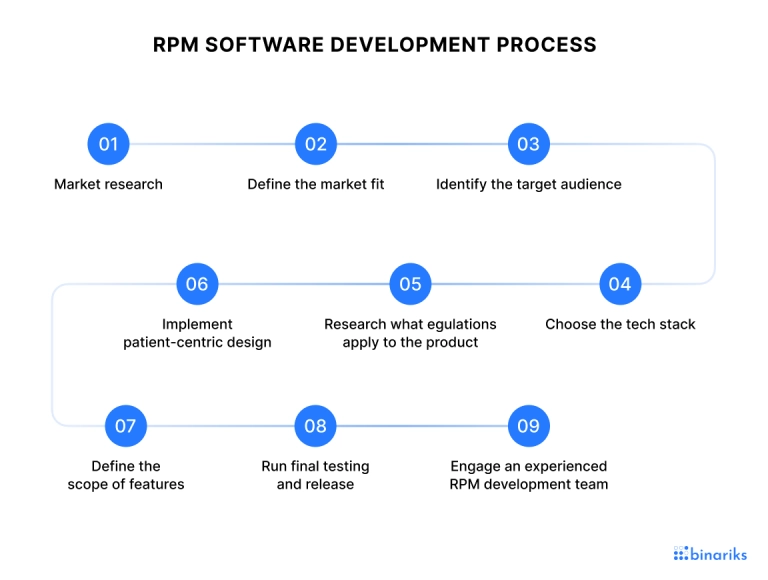
The companies that haven’t got all the necessary talent in-house usually delegate the remote patient monitoring app development to tech partners like Binariks. It’s vital that the remote patient monitoring development company has both a deep understanding of HIPAA regulation and technological excellence.
How much does it cost to develop RPM software
The cost of remote patient monitoring development is defined by various factors including features and functionalities, software complexity, the development team’s location and experience, compliance requirements, and deadlines.
According to some industry experts, the cost of designing an RPM solution might range from $50,000 to $500,000 or more depending on the features and functions offered. This cost estimate can be used as a rough guideline, but it is crucial to remember that the actual cost will vary greatly depending on the project's individual demands and requirements.
To get precise estimates of product engineering, address Binariks – an experienced remote patient monitoring development company. Our business development managers will engage technical experts to provide detailed pricing and help you prioritize the essential features.
Challenges in implementing patient-monitoring software
Different types of patient-monitoring software have different challenges, but there are a couple of extremely prevalent issues regardless of the specific software type:
- Challenges linked to the system's flexibility:
When working to develop a remote patient monitoring app, the team should pay attention to the adaptability and flexibility of a system.
In some scenarios, the load is constant throughout the day. Others may have fluctuating and unpredictable levels of load. This can happen when a patient wears a connected device only for a short time throughout the day, or some metrics are not captured consistently. In these cases, predicting the exact time the system reaches maximum load is hard.
One of the ways to solve this is by having powerful servers, which is very expensive. Therefore, adapting to the load is a more sustainable solution. DevOps engineers are tasked with making systems self-adjacent to survive unpredictable loads.
- Creating effective personalized notifications:
Personal notifications in RPM platforms are not just about collecting data. Users must receive timely and relevant notifications when specific metrics differ from the norm. However, the issue lies in defining the "norm" for a particular patient.
An individual approach requires considering many co-configurations to avoid false positive notifications. The burden of this task is on business analysts, who have to understand specific business contexts related to customers.
How can Binariks help create a remote patient monitoring platform?
Binariks has a track record of delivering interoperable healthcare solutions that comply with the HIPAA standard. Our offering isn’t limited to remote patient monitoring software development. We can also help you create custom turn-key healthcare interoperability, cloud, and telemedicine solutions.
So why work with Binariks? Here are five good reasons to consider launching remote patient tracking system development with us.
- Our experts have a thorough grasp of the HIPAA standard and will pick tech stacks that enable it. We are a certified AWS Select Consulting Partner, a Gold Microsoft Partner, and a Google Cloud Partner, one of the 1000 top Clutch remote patient monitoring software providers.
- We provide full-cycle remote patient monitoring app development capabilities including project managers, BA, QA, DevOps engineers, software programmers, architecture, and designers.
- Our tech experts provide realistic time/cost estimates for developing unique RPM apps due to their experience and understanding of the development process.
- We guarantee transparency and engagement enabled through a clear action plan, dedicated project managers, and constant communication.
- We have access to a big pool of tech talent and can expand teams when necessary. With us, you can work with world-class talents without extending your in-house programming crew.
We have a track record of delivering successful projects for healthcare providers. Here is a couple of them.
Web platform for patient monitoring and management
We helped a company with an AWS-powered platform integrated with several third-party products scale the solution. Binariks team helped the client compose the right architecture for the optimized application.
The solution stimulates communication between doctors and patients and records data from wearable tracking devices to simplify primary care. In addition, the client works with insurers and governmental agencies to reimburse Medicare supplied to beneficiaries automatically.
We used our technical expertise to deliver an architecture that would process increasing volumes of patients’ data; the engineers also improved the code repository and enhanced the stability and security of the solution, and optimized the CI/CD procedure to speed up the development lifecycle. The cherry on top was streamlining the insurance reimbursement process for governmental agencies.
Web platform and mobile application with a CRM
We helped a company that specializes in non-emergency medical transportation benefits simplify the process of integrating their solution with third-party administrators. Another part of our collaboration covered the engineering of centralized storage to support key business processes including information of vendors, health care information, services provided, insurance, and claims.
Our team conducted a detailed analysis, crafted, and implemented the renovation plan. As a result, we helped the client’s solution comply with HIPAA regulation through FHIR standard , facilitate integration with third-party systems, ensure stable solution performance, and activate Transport Security TLS 1.2.
Here’s a full list of success stories and healthcare solutions we’ve provided over the years. We can help you create your RPM application, integrate it with other services, implement IoT technologies, add AI and ML-driven analytics, and do many other things. Drop us a message about your product and we’ll get back to you pronto!Diabetes
FAQ
Share

